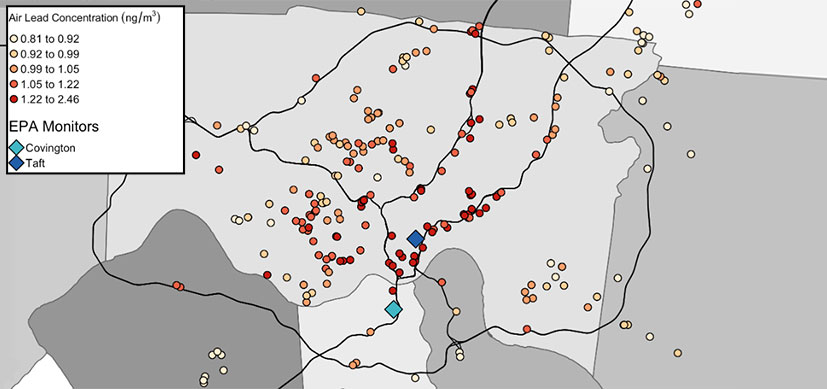Kimberly Yolton, PhD
- Director of Research Section, General and Community Pediatrics
- Professor, UC Department of Pediatrics
About
Biography
As a developmental psychologist and epidemiologist, I’m interested in exposures and experiences that may alter a child’s developmental trajectory from infancy through young adulthood. I collaborate on research projects on typical child development as well as those focused on the impact of exposures to environmental toxicants, opiates and stress during early development.
Early in my research, I studied prenatal exposure to drugs like cocaine and opiates on infant and child neurobehavioral outcomes, and then I discovered the impact that tobacco smoke can have on a child’s health and development. Studying tobacco smoke led to exploration of other environmental toxicants like metals, industrial chemicals and air pollution. I always balance my studies by accounting for other factors, such as stress, poverty and caregiver characteristics as they are also critical contributors to a child’s development.
Through a pregnancy and birth cohort study from Cincinnati, we have studied a variety of common environmental toxicants — tobacco smoke, air pollution, pesticides and industrial chemicals — and how they may impact child neurobehavior, health and neuroimaging outcomes. We completed our most recent follow-up on the children in 2019, at age 12. We are currently completing follow-up study visits at age 18.
I also collaborate with investigators from multiple institutions, both domestically and internationally, regarding neurobehavioral assessments and staff training strategies. We work to acquire the most appropriate outcome measures with the highest standards of reliability and validity. My ultimate goal is to identify short- and long-term neurobehavioral outcomes among infants and children from a variety of samples, advancing our understanding of developmental trajectories and factors that may alter outcomes.
As director of research for the Division of General and Community Pediatrics, I interact with researchers of all levels, providing support and guidance as they plan their projects. I am associate director of our National Research Service Award Fellowship in General Pediatrics, and I serve as training faculty on three T32 fellowship grants and for the Medical Scientist Training Program. I also hold a secondary appointment at the University of Cincinnati College of Medicine in the Department of Environmental and Public Health Sciences. These roles allow me to interact with medical students, graduate students, postdoctoral fellows and faculty, providing mentorship and research guidance.
I have been a researcher for more than 28 years and started working at Cincinnati Children’s in 2000. Some highlights of my research career include:
- Our longitudinal pregnancy and birth cohort continues to follow children of pregnant women who were enrolled in the study in 2003-2006 and has resulted in more than 100 scientific publications.
- We were the first to describe associations between exposure to secondhand smoke and disturbances to child sleep. We were also among the first to describe associations between exposure to secondhand smoke and deficits in reading, math and problem-solving abilities in children.
- I was involved in the development of the Neonatal Intensive Care Unit (NICU) Network Neurobehavioral Scale (NNNS), a specialized assessment tool for evaluating early infant neurobehavior. This test is often used with neonates in prenatal drug exposure studies. I have used it extensively in studying the impact of prenatal exposure to environmental toxicants, finding different patterns of neurobehavioral outcomes in relation to a variety of different exposures. I regularly conduct training sessions on the proper uses of this tool and the newly released NNNS-II.
- I have been involved in follow-up studies of high-risk infants directed by the NICHD-funded Neonatal Research Network (NRN) for more than 25 years.
- I received the Senior Research Achievement Award at Cincinnati Children’s in 2019.
PhD: Family Relations & Human Development, Developmental Psychology, The Ohio State University, Columbus, OH, 1992.
Fellowship: Pediatric Environmental Health, Cincinnati Children’s Hospital Medical Center, Cincinnati, OH, 2000-2003.
Services and Specialties
Interests
Development, behavior, and mental health from infancy to adulthood
Research Areas
Publications
Gestational PBDE concentrations and executive function in adolescents with self- and caregiver-report: The HOME study. Environmental Research. 2025; 273:121256.
Gestational PBDE concentrations, persistent externalizing, and emerging internalizing behaviors in adolescents: The HOME study. Environmental Research. 2024; 252:118981.
Per- and polyfluoroalkyl substances and bone mineral content in early adolescence: Modification by diet and physical activity. Environmental Research. 2024; 252:118872.
Environmental predictors of children's executive functioning development. Child Neuropsychology. 2024; 30:615-635.
Air pollution exposure and social responsiveness in childhood: The cincinnati combined childhood cohorts. International Journal of Hygiene and Environmental Health. 2023; 251:114172.
Early-life exposure to a mixture of organophosphate esters and child behavior. International Journal of Hygiene and Environmental Health. 2023; 250:114162.
Characterizing the Adolescent Premature Ovarian Insufficiency Phenotype: A Case Control Study. Journal of Pediatric and Adolescent Gynecology. 2023; 36:122-127.
Early exposure to flame retardants is prospectively associated with anxiety symptoms in adolescents: A prospective birth cohort study. Depression and Anxiety. 2022; 39:780-793.
Childhood urinary organophosphate esters and cognitive abilities in a longitudinal cohort study. Environmental Research. 2022; 215:114265.
Physical activity modifies the relation between gestational perfluorooctanoic acid exposure and adolescent cardiometabolic risk. Environmental Research. 2022; 214:114021.
From the Blog
Prenatal Exposure to PBDEs Linked to Adolescent Behavioral Concerns
Kimberly Yolton, PhD, Kim M. Cecil, PhD7/18/2024
Multi-Phthalate Exposure Increases Preterm Birth Risk
Kimberly Yolton, PhD7/11/2022
Airborne Lead Exposure in Childhood Linked to Behavioral Problems in Adolescence
Kimberly Yolton, PhD, Cole Brokamp, PhD ...3/24/2021
$5M Grant to Support Exploring Link Between Air Pollution and Mental Health
Kimberly Yolton, PhD, Kim M. Cecil, PhD ...3/2/2021
Plastics and Pesticides: Tracking Down the Real Risks
Kimberly Yolton, PhD6/25/2019









